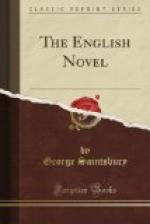Yet almost thoroughing-going defence is, as far as the novels (our only direct business) are concerned, far from difficult; and the present writer, though there are perhaps not a dozen consecutive pages of Kingsley’s novels to which, at some point or other, he is not prepared to append the note, “This is Bosh,” is prepared also to exalt him miles above writers whose margins he would be quite content to leave without a single annotation of this—or any other—kind. In particular the variety of the books, and their vividness, are both extraordinary. And perhaps the greatest notes of the novel generally, as well as those in which the novel of this period can most successfully challenge comparison with those of any other, are, or should be, vividness and variety. His books in the kind are seven; and the absence of replicas among them is one of their extraordinary features. Yeast, the first (1848), and Alton Locke, the second (next year), are novels of the unrest of thought which caused and accompanied the revolutionary movement of the period throughout Europe. But they are quite different in subject and treatment. The first is a sketch of country society, uppermost and lowermost:[25] the second one of town-artisan and lower-trade life with passages of university and other contrast. Both are young and crude enough, intentionally or unintentionally; both, intentionally beyond all doubt, are fantastic and extravagant; but both are full of genius. Argemone Lavington, the heroine of Yeast, is, though not of the most elaborately drawn, one of the most fascinating and real heroines of English fiction; an important secondary character of the second book, the bookseller Sandy Mackaye, is one of its most successful “character-parts.” Both, but especially Yeast, are full of admirable descriptive writing, not entirely without indebtedness to Mr. Ruskin, but very often independently carried out, and always worthy of a “place on the line” in any gallery. There is much accurate and real dialogue, not a little firm character-drawing. Above all, both are full of blood—of things lived and seen, not vamped up from reading or day-dreaming—and yet full of dreams, day and other, and full of literature. Perhaps “the malt was a little above the meal,” the yeast present in more abundant quality than the substances for fermentation, but there was no lack even of these.




